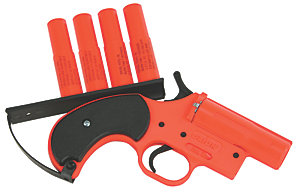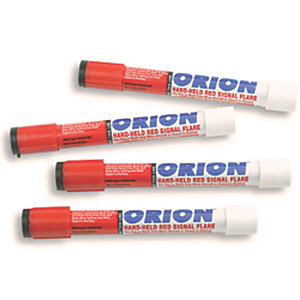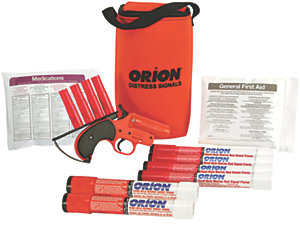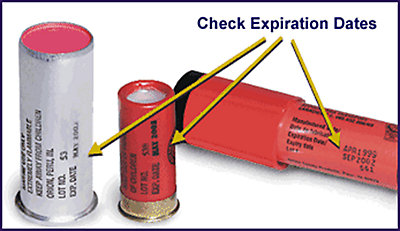Guide to Flare Usage and Safety
 As boaters, we all understand the necessity of having marine flares on board – but understanding how to use them in an emergency just may save your life. Below we answer some basic questions on USCG requirements and the safe usage and disposal of flares.
As boaters, we all understand the necessity of having marine flares on board – but understanding how to use them in an emergency just may save your life. Below we answer some basic questions on USCG requirements and the safe usage and disposal of flares.
What are the USCG Requirements?
By law, a visual distress signal must be carried “on all boats that are operated on the high seas, coastal waters (including the Great Lakes), the territorial seas, and all waters directly connected to the Great Lakes or the territorial seas up to a point where the waters are less than two miles wide.” The following vessels are not required to carry day signals, but must carry night signals when operating from sunset to sunrise:
- Recreational boats less than 16 feet in length
- Boats participating in organized events, such as races, regattas, or marine parades
- Open sailboats less than 26 feet in length that are not equipped with propulsion machinery
- Manually propelled boats
If required, you must have a minimum of three signals for both day and night usage and they must be approved by the U.S. Coast Guard. Since some signals meet both day and night use requirements (see below), having three of this type would mean you are legal. That said, most experts recommend that you have a minimum of six to make sure you have enough to handle a real emergency.
What Kind of Flare Should I Use?

- Red Parachute Flare – approved for both day and night usage, this is a high powered aerial signal that is meant to get attention and provide a visual location. These typically launch a 30,000 candlepower meteor nearly 1,000 feet into the air, with which will stay aloft and burn for up to 40 seconds.
- Red Meteor – approved for both day and night usage, these flares are also meant to get attention and help provide a visual location. There are several types, but the two main types are 12-gauge aerial flares (used with a 12-gauge launcher) that will launch up to 500 feet and provide a 16,000 candlepower meteor that will stay aloft for about 7 seconds; or 25mm aerial flares (used with a 25mm launcher) that launch up to 375 feet with a 33,000 candle power meteor that will stay aloft for up to 7 seconds. A 25-gauge aerial can often be seen from over 25 miles away!
- Hand Held Red Flare – approved for both day and night usage, these flares are used to help the rescuer pinpoint your location once you've been seen. They provide about 700 candlepower for approximately 3 minutes.
- Orange Handheld or Floating Smoke Signals – approved for day use only, these are also used to help the rescuer pinpoint your location. Average burn time for a hand-held is 1 minute and approximately 4 minutes for a floating canister.
As you can imagine – which flare you choose should be dictated by what you are trying to do (attract attention or pinpoint your location), and with how far away help may be located.
 I'm in Trouble – How Soon Should I Activate My Flares?
I'm in Trouble – How Soon Should I Activate My Flares?
- First off – always stay with your boat if it is safe to do so. A boat is much easier to spot than a swimmer, so don't jump ship unless you are in immediate danger.
- Conserve your aerial signals until you are reasonably sure of being sighted. Wait until you see or hear a vessel or aircraft before using "one-time" signals.
- Once you've sighted help, the U.S. Coast Guard recommends that you fire two aerial flares – one immediately after the other – so rescuers can confirm the sighting and the direction of the signal. If using a parachute flare, one is fine as it has an adequate burn time to confirm sighting and position.
- Once you aerial flare has been seen, you must make sure your rescuer can pinpoint your location by using hand-held flares. The surface-to-surface sighting range on water is approximately 3 to 5 miles, depending on boat elevation. If a rescuer is 5 miles away and running at 20 miles per hour, it will take 15 minutes to reach you. Therefore, you should have a minimum of 12 minutes of signal burn time for a strong homing signal. Hand-held flares last approximately 3 minutes – so we recommend you have 6 to be on the safe side as not all boats travel that fast.
- Make sure to familiarize yourself with your signals before you leave shore. Time is important in any emergency and it shouldn't be spent reading instructions.
How Do I Store My Flares?
While flares are classified as flammable, they are generally safe and stable if stored correctly. There is no threat of mass explosion, nor is there any threat of an individual flare exploding. They should be stored in a cool, dry place away from excessive heat (above 167 degrees F), and away from sparks or flames. The normal recommended storage temperatures are 40 degrees to 90 degrees F. Do not expose flares to water for periods of longer than 10 minutes.
What Do I Do With My Expired Flares?
Marine flares expire 42 months after the manufacture date in accordance with the Coast Guard requirements, so check the expiration dates on your flares and signals as shown below. If they have expired or will expire during the boating season, you must replace them...it's the law!
To dispose of expired flares, Orion recommends the following methods:
- Donate expired flares to local Coast Guard Auxiliary or Power Squadron for use in their training classes.
- Contact a local law enforcement or the fire protection agency for their advice on proper visual distress signal disposal.
- Retain flares for back-up use to expand signaling time in the event of an emergency.
- NEVER jettison visual distress signals overboard.
- NEVER activate marine flares in a non-emergency situation on or near regulated water.
- NEVER dispose of flares in household trash.
For disposal in the Seattle area
King County residents may dispose of their expired flares at four recycling locations – found here. They will accept 10 ordinances per person. Kitsap County Sherriff will accept all flares which are individual (non-business). Other local counties have policies which vary by the situation, so please contact local law enforcement for further information.
We hope you've found this Navigator on flare usage and safety helpful, but if you have any additional questions, please don't hesitate to contact our safety experts at (800) 426-6930. Fisheries Supply carries a wide range of marine flares - so if your flares have expired, replace them right away!
Want to learn how to activate a hand-held flare? Click here.
